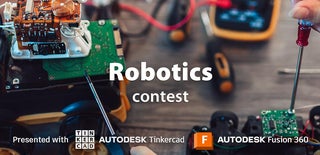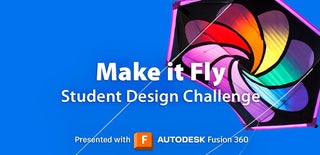Introduction: Bits4Bots - Build a Wind-Powered Car (+Bonus Tinkercad Sim Lab Test)
Welcome to the exciting world of wind-powered cars! In this advanced version of the project, we will use common materials to create a mini car that moves using the power of the wind. This activity is perfect for kindergarteners and first graders who are ready for a slightly more challenging engineering adventure.
About me: I am an Electrical Engineer and STEM advocate who mentors students grade K-12. I currently teach free STEM classes at the local MLK library in Palm Bay, Florida - Brevard County for elementary students.
This project will be one of many unique designs by Bits4Bots. Look for more styles coming soon :)
Follow us for more cool projects and visit us at www.bits4bots.com
Supplies
- Large wood craft sticks with 5 holes (4.8mm holes)
- 5V DC motor ( 2mm shaft)
- Motor mount
- Thumbscrew and hardware or Medium 1-1/4" Bolts
- Plastic propeller *Choose from 2, 3, or 4 Vane
- L-shaped Just Clip It connectors or here
- 1-inch axles (2mm diameter)
- Wheels (2mm diameter)
- AA batteries
- AA 2 cell holder with switch & wires
- Double-sided tape
- Balloon
- Paper clip
Step 1: Prepare the Base
- Choose 3 large wood craft sticks. (Color is optional. One for the base, and two for the left & right)
- Attach the motor mount to the base by inserting the large threaded screw through the hole of the plastic mount.
- Check that the motor mount is sitting on the top side. The bottom side of the base wood stick will have the large screw ready for the thumbscrew to be attached.
- Twist the plastic thumb nut onto the screw.
- Assemble the large wood craft sticks in a "U" shape using four (4) L-shaped Just Clip It plastic connectors.
*You might need an adult's help to attach the sticks securely.
Step 2: Attach the Wheels and Axles
- Using the 4.8mm holes of the left & right structure of the car, insert the 1 inch axle through the second hole from the top.
- Using your index and thumb finger, gently press fit both wheels by aligning the 3mm center with the axle.
Step 3: Create the Propeller and Wind Propulsion
- Slide the motor into the motor mount with the shaft facing outward.
- Gently press the propeller onto the motor.
- Using double-sided tape, adhere the AA battery holder to the opposite end of the motor.
- Carefully attach the red and black wires to the motor as pictured. (Pay attention to polarization + & -)
The propeller with start to spin! The breeze should flow from the propeller facing you. If it does not you may need to reverse the red and black wires.
Step 4: Let's Test It!
Find an open space with a clear path for the car to travel. Hard wood or tiled floors will work best.
- Turn on the DC motor. The spinning propeller will create a wind force that pushes the car forward.
- Experiment with the angle of the propeller to see how it affects the car's movement.
Step 5: Race and Decorate
- Gather your friends, classmates, or family members for a wind-powered car race!
- Decorate your car with additional stickers, paint, numbers, drawings, or other fun materials :)
*Consider using 3D software like Tinkercad to design an aerodynamic hood for the front 4.8mm hole near the front wheels.
Decorate: Consider adding lights to your project with BitStix
Try 3D printing (stl) or laser cutting (svg) the craft sticks for a different size or weight property.
Ideas: Modify the "wind car hood" design by adding the letter of your first name or lucky number.
3 hole wide craft stick
5 hole wide craft stick
Step 6: Explore and Learn
- Discuss with the kids how the motor and propeller work together to create wind force, propelling the car forward. Introduce basic concepts of energy conversion in a simple way.
- Encourage kids to think about ways to optimize their wind-powered cars. They can increase the base of the car by adding more sticks, the number of vanes on the propeller, or the angle of the motor to experiment with speed and efficiency.
Conclusion:
Congratulations! You've successfully built an advanced wind-powered car using common materials and components. This project introduces young learners to more complex engineering concepts while providing hands-on fun. Keep exploring and innovating as you learn more about science and technology!
Step 7: Clean Up and Storage
Consider storing your items neatly in a plastic compartment storage box.
Pictured: 3 rows by 5 columns.
Dimensions: 10.9 X 6.5 X 2.2 inch
Step 8: Curriculum/Instructional Materials: Wind-Powered Car Project
Grade Level: Kindergarten and First Grade
Standards Alignment:
Science:
- K-PS2-1: Plan and conduct an investigation to compare the effects of different strengths or different directions of pushes and pulls on the motion of an object.
- 1-PS4-4: Use tools and materials to design and build a car that uses wind to solve the problem of traveling over a distance.
Mathematics:
- Common Core State Standards (CCSS) for Mathematics:K.MD.A.2: Directly compare two objects with a measurable attribute in common, to see which object has "more of"/"less of" the attribute, and describe the difference.
Learning Objectives:
By the end of this curriculum or instructional materials, students will be able to:
- Understand basic concepts of wind energy and its ability to move objects.
- Design and create a wind-powered car using provided materials.
- Explore how the size and shape of a sail impact the movement of the car.
- Demonstrate how a motor and propeller can harness wind energy for propulsion.
- Experiment with adjusting variables (motor angle, propeller speed) to optimize car performance.
- Collaborate with peers to share ideas, troubleshoot, and race wind-powered cars.
- Communicate findings and observations about wind energy and car movement.
Student Assessment Criteria:
Design and Build:
- Student successfully assembles a wind-powered car using provided materials.
- Car includes a motor, propeller, sail, and axles.
- Components are securely attached and aligned.
Scientific Understanding:
- Student explains the concept of wind energy and how it can move objects.
- Student describes the relationship between the motor, propeller, and car movement.
Experimentation and Optimization:
- Student demonstrates the ability to adjust the sail angle and propeller speed.
- Student observes and records how adjustments affect car movement.
Collaboration and Communication:
- Student participates in group discussions, sharing ideas and suggestions.
- Student works effectively with peers to troubleshoot and improve car design.
Presentation:
- Student effectively communicates findings and observations to the class.
- Presentation includes clear descriptions of variables tested and their impact on car movement.
Assessment Methods:
- Observation: Monitor student engagement, collaboration, and participation during the building process and group discussions.
- Hands-On Performance: Evaluate the functionality and quality of each student's wind-powered car.
- Presentation or Report: Assess the clarity, depth, and accuracy of students' explanations during their presentations or written reports.
- Experimentation and Recording: Review the accuracy and completeness of students' recorded observations during experimentation.
By aligning the curriculum with standards, setting clear learning objectives, and establishing assessment criteria, you create a structured and educational experience that helps students develop both scientific understanding and practical skills while having fun building wind-powered cars.
Step 9: Utilizing Math in Engineering
In addition to exploring scientific concepts, this wind-powered car project provides opportunities for students to engage with practical math applications, which are also aligned with both NGSS and CCSS. Engineers, much like young learners in this project, use math to solve real-world challenges.
1. Calculating Payload:
Engineers often need to determine how much weight a structure or vehicle can carry. In the context of wind-powered cars, students can calculate the payload capacity by considering the maximum weight the car can carry while still moving efficiently. They can use math to compare different objects' weights and understand how these weights affect the car's performance.
2. Understanding Weight:
By comparing and contrasting the weights of different objects that can be placed on the wind-powered car, students practice measurement and quantitative reasoning. They can calculate the weight difference between various objects and explore how this difference impacts the car's movement.
3. Analyzing Friction:
Friction is an essential concept in engineering. Students can experiment with the car's movement on various surfaces and measure how friction affects its speed. By quantifying these observations, students can relate the surface type to the amount of friction and consider ways to minimize it, similar to how engineers optimize designs for efficiency.
Through these math-related aspects, students not only address the NGSS and CCSS standards but also gain insight into how math plays a role in engineering and problem-solving. By incorporating these considerations, the wind-powered car project becomes a well-rounded learning experience that integrates science, math, and hands-on exploration.
Step 10: Multiple-choice Worksheet
Wind-Powered Car Project Q&A Worksheet
Name:___________________________________
*Instructions: Read each question carefully and select the correct answer.*
Question 1:
What is the main source of power that moves the wind-powered car?
A) Solar energy
B) Wind energy
C) Electrical energy
D) Nuclear energy
Question 2:
Which part of the wind-powered car captures the wind's energy and helps it move?
A) Wheels
B) Motor
C) Propeller
D) Axles
Question 3:
What role does the propeller play in the wind-powered car?
A) It generates wind energy and pushes the car
B) It steers the car
C) It generates electricity
D) It keeps the car balanced
Question 4:
How does adjusting the angle of the motor affect the wind-powered car's movement?
A) It makes the car stop moving
B) It has no effect on the car's movement
C) It makes the car move backwards
D) It influences the direction and speed of the car's movement
Question 5:
What can engineers calculate to understand how much weight the wind-powered car can carry?
A) The car's top speed
B) The number of wheels
C) The wind speed
D) Payload capacity
Question 6:
Why is it important for engineers to understand friction in the wind-powered car?
A) Friction helps the car move faster
B) Friction doesn't affect the car's movement
C) Friction slows down the car's movement
D) Friction makes the car go in reverse
Question 7:
How can young learners use math in this project?
A) To predict the weather
B) To create art on the car
C) To calculate payload, weight, and friction
D) To build a motor for the car
Question 8:
If the wind-powered car can carry a maximum weight of 50 grams and it already has objects weighing 25 grams onboard, how much more weight can it carry?
A) 20 grams
B) 25 grams
C) 70 grams
D) 10 grams
Answers:
1) A
2) C
3) A
4) D
5) D
6) C
7) C
8) B
Advanced topics:
Question 9:
Imagine the wind-powered car moving on a hard surface and a soft surface. Which surface will likely have more friction, causing the car to slow down?
A) Hard surface
B) Soft surface
Question 10:
If the wind-powered car moves 15 centimeters on a hard surface before stopping and 10 centimeters on a soft surface before stopping, which surface has less friction?
A) Hard surface
B) Soft surface
Why?
Question 9:
Imagine the wind-powered car moving on a hard surface and a soft surface. Which surface will likely have more friction, causing the car to slow down?
Answer:
B) Soft surface
Explanation:
A soft surface, such as grass or carpet, usually has more friction than a hard surface like a smooth floor. The roughness of the soft surface creates more resistance against the car's movement, making it slow down more compared to the smoother and less resistant hard surface.
Question 10:
If the wind-powered car moves 10 centimeters on a soft surface before stopping and 15 centimeters on a hard surface before stopping, which surface has less friction?
Answer:
A) Hard surface
Explanation:
The wind-powered car moved a greater distance (15 centimeters) on the hard surface before stopping, indicating that the soft surface has more friction. A softer surface with more friction would have caused the car to stop after a shorter distance.
Less friction means that there is less force opposing the motion of an object, making it move more freely.
Feel free to use this updated multiple-choice Q&A worksheet, including the math question, for your Kindergarten and 4th-grade students!
Step 11: Notes:
Large popsicle stick weight:
On average, a large popsicle stick can weigh around 3 to 5 grams each.
5V DC motor with plastic propeller weight:
A small 5V DC motor with a plastic propeller might weigh around 10 to 20 grams, depending on the specific model and design.
Assuming that each large popsicle stick weighs around 4 grams and the motor with propeller weighs around 15 grams, the approximate weight of 3 large popsicle sticks and a 5V DC motor with a plastic propeller would be:
3 popsicle sticks * 4 grams each + 15 grams (motor with propeller) = 12 + 15 = 27 grams
Please note that these are rough estimates and actual weights may vary slightly based on the specific materials used and their dimensions.

This is an entry in the
Project-Based Learning Contest


















Comments